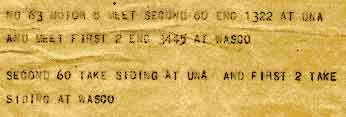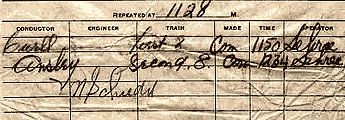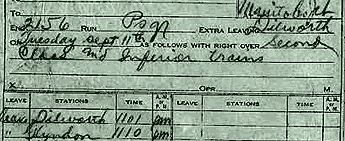Forms 19 & 31:
Non-SP Train Orders
Non-SP Train Orders
Many, perhaps the majority, of North American Railroads used Form 19 and Form 31 train orders, something to which Southern Pacific did not subscibe. Form 19's can be hooped up to a train passing at speed, but delivery of Form 31's requires that the train be stopped and that its engineer and conductor each personally sign the order, including the operator's copy, before the train can be cut loose.
SP eschewed the Form 31 arrangement. Instead, it stipulated that the train be stopped, and the conductor or engineer be present in the train order office before the operator may repeat the order back to the dispatcher for final completion and dispatcher initials. The reason for this and the Form 31 signatures is to make sure that the train and engine crew understands that their train will be restricted in some manner at that point. An example would be to hold a train at that point so that an inferior train could be advanced against it.
On this page you will find a random selection of North American train orders for comparison to SP's flimsies, as presented in A Train Order Primer, Part 2. It should become apparent that, despite the variation of forms, the basic tenets in the Movement of Trains (see A Train Order Primer, Part 1) remain the same. Thus, you will find much in common.
As a matter of reference, Southern Pacific train orders dimensions varied slightly over the years, but were approximately 6.75" x 9''; clearances sizes (examples here) varied significantly over the years. All dimensions below are in inches.
Atchison, Topeka & Santa Fe

Steam and motor cars still were alive and well in California's San joaquin Valley in 1952. Like SP, Santa Fe did not use 19 & 31 Forms.
Clearance: 6.75x4.86; TO: 6.75x9
Clearance: 6.75x4.86; TO: 6.75x9

Clearance: 6.75x5; TO: 7x9.75

CP Form 31's are larger than their Form 19's, a nice arrangement when it comes to keeping things sorted out. Possibly CP constructed them thus for this very reason - we'd like to think so. Most SP officials would consider this mollycoddling the crews, however.
Clearance: 6.5x3.5; Form 19: 6.5x7.38; Form 31: 6.5x9.86
Note: Canadien National clearances and forms are very similar in size and overall appearance to CP's.

Clearance: 6.75x4.25; Register Check: 3.19x5.5; TO: 7x9.5

Clearance/register check: 3.25x6; Form 19: 6.75x8.25

The running order cut at Manitoba Jct. two decades earlier, on September 11, 1928, is our favorite train order form. It's the equivalent of a Southern Pacific Form G (example 6), which combines a running order with a column wait. We don't know why railroads didn't do more of this sort of boilerplate thing in train order days - it's certainly the norm now. It even lets you know that said extra train was a passenger movement. For comparative purposes, we have a standard Form 19 running order cut at the same station two days earlier.

